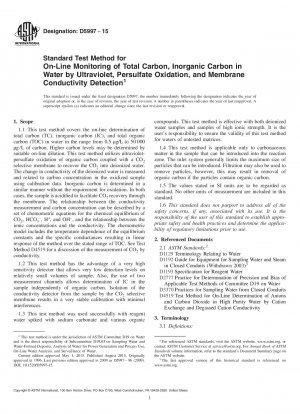ASTM D5997-15
Standard Test Method for On-Line Monitoring of Total Carbon, Inorganic Carbon in Water by Ultraviolet, Persulfate Oxidation, and Membrane Conductivity Detection
- Standard No.
- ASTM D5997-15
- Release Date
- 2015
- Published By
- American Society for Testing and Materials (ASTM)
- Latest
- ASTM D5997-15
- Scope
5.1 This test method is useful for detecting and determining organic and inorganic carbon impurities in water from a variety of sources including industrial water, drinking water, and waste water.
5.2 Measurement of these impurities is of vital importance to the operation of various industries such as power, pharmaceutical, semiconductor, drinking water treatment, and waste treatment. Semiconductor and power applications require measurement of very low organic carbon levels (TOC < 1 μg/L). Applications in pharmaceutical industries range from USP purified water (TOC < 500 μg/L) to cleaning applications (500 μg/L < TOC < 508201;000 μg/L). Drinking waters range from <100 μg/L to 258201;000 μg/L and higher. Some of these applications may include waters with substantial ionic impurities as well as organic matter.
5.3 Measurement of inorganic carbon as well as total organic carbon is highly important to some applications, such as in the power industry.
5.4 Continuous monitoring and observation of trends in these measurements are of interest in indicating the need for equipment adjustment or correction of water purification procedures.
5.5 Refer to the Bibliography section for additional information regarding the significance of this test method.
1.1 This test method covers the on-line determination of total carbon (TC), inorganic carbon (IC), and total organic carbon (TOC) in water in the range from 0.5 μg/L to 508201;000 μg/L of carbon. Higher carbon levels may be determined by suitable on-line dilution. This test method utilizes ultraviolet-persulfate oxidation of organic carbon coupled with a CO2 selective membrane to recover the CO2 into deionized water. The change in conductivity of the deionized water is measured and related to carbon concentration in the oxidized sample using calibration data. Inorganic carbon is determined in a similar manner without the requirement for oxidation. In both cases, the sample is acidified to facilitate CO2 recovery through the membrane. The relationship between the conductivity measurement and carbon concentration can be described by a set of chemometric equations for the chemical equilibrium of CO2, HCO3−, H+, and OH−, and the relationship between the ionic concentrations and the conductivity. The chemometric model includes the temperature dependence of the equilibrium constants and the specific conductances resulting in linear response of the method over the stated range of TOC. See Test Method D4519 for a discussion of the measurement of CO2 by conductivity.
1.2 This test method has the advantage of a very high sensitivity detector that allows very low detection levels on relatively small volumes of sample. Also, the use of two measurement channels allows determination of IC in the sample independently of organic carbon. Isolation of the conductivity detector......
ASTM D5997-15 Referenced Document
- ASTM D1129 Standard Terminology Relating to Water
- ASTM D1192 Standard Guide for Equipment for Sampling Water and Steam in Closed Conduits
- ASTM D1193 Standard Specification for Reagent Water
- ASTM D2777 Standard Practice for Determination of Precision and Bias of Applicable Methods of Committee D-19 on Water
- ASTM D3370 Standard Practices for Sampling Water from Closed Conduits
- ASTM D4519 Standard Test Method for On-Line Determination of Anions and Carbon Dioxide in High Purity Water by Cation Exchange and Degassed Cation Conductivity
ASTM D5997-15 history
- 2015 ASTM D5997-15 Standard Test Method for On-Line Monitoring of Total Carbon, Inorganic Carbon in Water by Ultraviolet, Persulfate Oxidation, and Membrane Conductivity Detection
- 1996 ASTM D5997-96(2009) Standard Test Method for On-Line Monitoring of Total Carbon, Inorganic Carbon in Water by Ultraviolet, Persulfate Oxidation, and Membrane Conductivity Detection
- 1996 ASTM D5997-96(2005) Standard Test Method for On-Line Monitoring of Total Carbon, Inorganic Carbon in Water by Ultraviolet, Persulfate Oxidation, and Membrane Conductivity Detection
- 1996 ASTM D5997-96(2000) Standard Test Method for On-Line Monitoring of Total Carbon, Inorganic Carbon in Water by Ultraviolet, Persulfate Oxidation, and Membrane Conductivity Detection

Copyright ©2024 All Rights Reserved